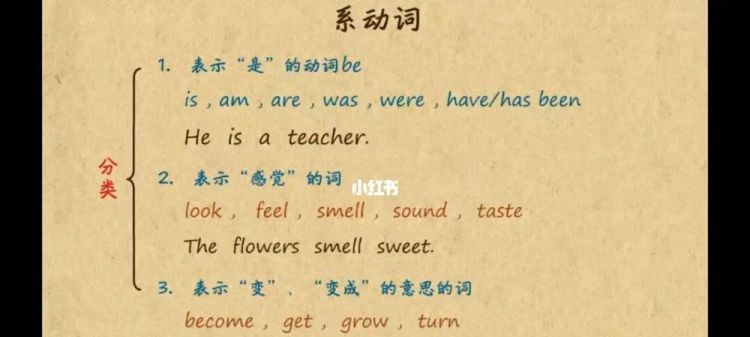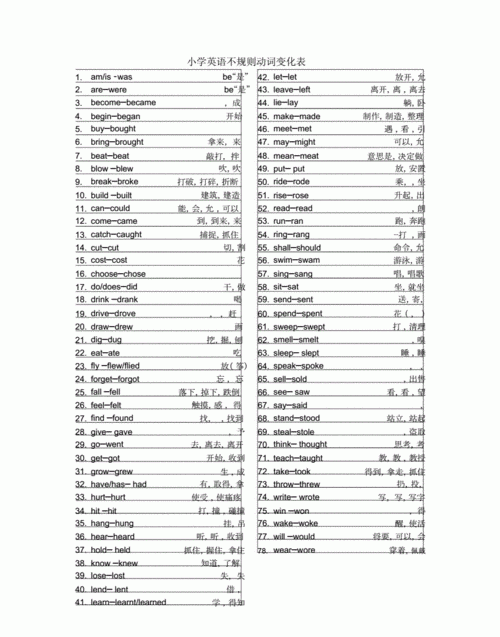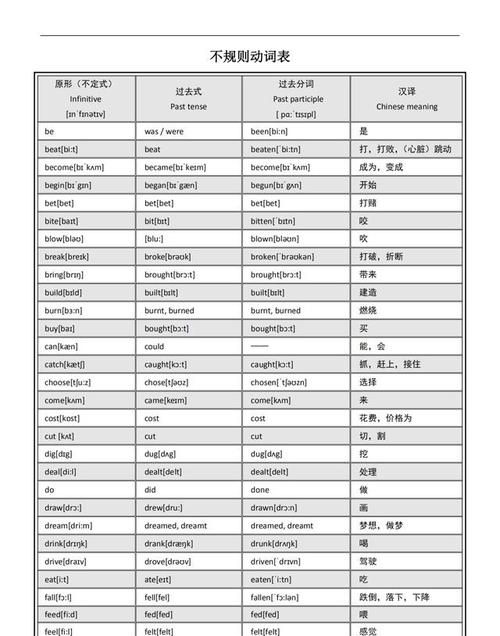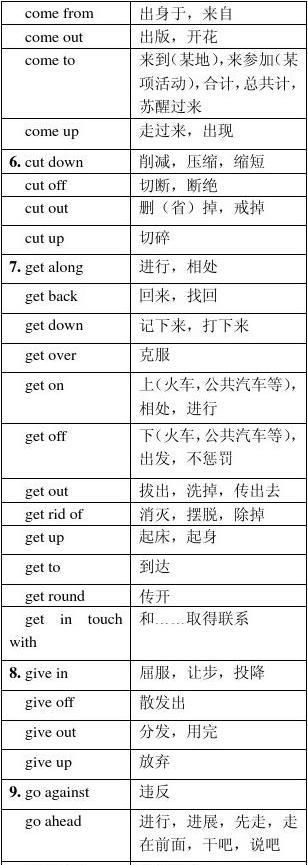本文目录
有哪些常用动词他们的用法英语
动词有be动词啦,助动词等啦~
情态动词是一种本身有一定的词义,表示说话人的情绪,态度或语气的动词,但不能单独作谓语,只能和其他动词原形构成谓语.
情态动词数量不多,但用途广泛,主要有下列:
can (could),may (might),must,need,ought to,dare (dared),shall (should),will (would) .
情态动词的位置:
情态动词在句中放在谓语动词之前,谓语动词前若有助动词,则在助动词之前,疑问句中,情态动词则在主语之前.
情态动词的特点:
情态动词无人称和数的变化,情态动词后面跟的动词需用原形,否定式构成是在情态动词后面加 "not".个别情态动词有现在式和过去式两种形式,过去式用来表达更加客气,委婉的语气,时态性不强,可用于过去,现在或将来.
一、表示“使/让……”概念的动词
这类动词常见的有have,let,make,get,keep,drive,send,leave,force,
cause等.它们后边分别可跟不定式,分词,形容词、介词短语,名词等作宾语补足语.
例如:I felt sorry to have kept you waiting for me so long.对不起,让你久等了.
The victory sent our spirits rising.胜利使得我们情绪高涨.
二、不定式做宾补,不定式符号可以省略的动词
常见的有see,watch,hear,observe,feel,notice,listen to,look at等感官动词及表示使役概念的have,let,mak等.这类词在变为被动语态时,其后不定式符号to通常要补出.
例如:We are made to work far into the night.我们被迫干活到深夜.注:在这种结构中,watch,have,let一般不变为被动语态.如:The boy was watched to come out.(错误)
三、不定式作宾语补足语、其后内容省略而只保留不定式符号的动词.此类动词常见的有refuse,want,intend,oblige,mean,expect,tell,hope,like,love,
plan,try,prefer,wish等.
例如:-----Why did you cause the baby cry?
------I didn't mean to.
四、引导宾语从句、虚拟预期的动词.这类动词在引导宾语从句时为should+动词原形,should可以省略,这类动词有order,demend,suggest,insist,
require,advise,decide,propose等.
例如:He orderd that we should do it at once.
他要求我们立即完成这项工作.
He adviced we should do more speaking practising in order to improve our English.他建议我们要想提高英语水平应多练习说话.
五、形主动、意义被动的词.常见的有work,open,close,write,cut,
look,teach,operate,run,keep,burn,last等.此类词的主语常为“物”而不是“人”.而且还常与表示特征、状况、行为、方式的副词well,easily,long等连用.
例如:The clothing sells well.
This kind of fruit can keep long.
六、行为动词充当系动词.这类动词不能单独构成动词词组,其后须带有表语(名词、形容词、副词、介词短语,不定式,V-ing,V-ed)构成系表结构,常见的有feel,sound,taste,look,smell,seem,appear,become,turn,grow,make,go,run,keep,stay,prove等.
例如:It sounded like a train that was going under my house.
听起来,象有火车在楼下飞驰而过.
Keep fit,study hard and wok well.身体好,学习好,工作好.
七、只接名词作宾语的动词.此类动词常见的有:appreciate,advice,
suggest,compete,finish,consider,enjoy,imagine,mind,miss,
practise,keep,delay,risk,excuse,resist,avoid,escape,admit,forgive,permit,require,prevent,pardon,allow等.
例如:I appreciate her devoting herself to the cause of education.我非常钦佩她献身教育的精神.
Do you mind my asking a question?我问你一个问题你不介意吧?
八、既可接现在分词又可接过去分词作宾补的动词.此类动词常见的有:get,keep,have,leave,find,see,notice,hear等.
例如:The two cheats had the lightes burning all night long.
Yesterday XiaoMing had his hair cut,I hardly recognized him.
九、同一词语用作及物动词与不及物动词.此类动词的及物与不及物用法是有区别的,常见的有;work,wait/wait,for,lie/lay,raise/rise,
sit/seat,serve等.
例如:If you have any question to ask in class,you can raise your hands.课堂上有什么问题可以举手发问.
The sun rising,we started out.太阳升起来了,我们便开始上路.
十、构成固定短语的“短语动词”.此类动词在英语中数量较大.如;act as充当,believe in相信,come across遇见,deal with处理,engage in从事,
lead to导致,refer to提到,send for派人前往,cut in插嘴 die out灭绝,
rise up起义,set off出发,warm up暖和起来,make fun of取笑,
make friends with与……交朋友,set fire on点火,date back to追溯到,
get along with 与……相处,look forward to期望,run out of用光,
do away with废除.
例如:We must look into the matter immediately.
我们必须马上调查此事.
The old should learn form the young and keep up with.
老年人应向青年人学习,跟上时代发展的步伐.

英语中最常用的200个动词
be动词:am,is,are,was,were,been;
助动词:do,did,done;
情态动词:can,may,must,need,ought to;
一般动词:walk,read,write,sing,dance,drink,drive,make,play,hit,look,dig,find,bear,beat,become,begin,blow,build,choose,catch等等,太多了.

英语常用不规则动词表
become
carry carry sb back(to sth) 使回忆carry on 继续移动 carryout 履行,执行
come come up with 提出/找到 come up 发生,出现 comeback 回来come true实现
have ”有“-”某人或某物有什么” eg:I have an apple.
“吃;喝” eg:Do you have lunch?
get get along with 与...相处;进展get down 记下 get over 克服 get on 上车、船、飞机
get away from 离开
go go through 经历 ;仔细检查;履行
go to a movie 去看电影 go shopping 去购物
go to work 去上班 go fishing 去钓鱼
go to bed 去睡觉 go dancing 去跳舞
go home 回家 go swimming去游泳
make “促使” ·1‘“make +宾语 +(省略to)do”迫使某人做某事被动语态:be made to do.
eg:The boy make the girl cry.=The girl was made to cry by boy.
put put down 放下;降落put off 推迟 put sth back 将某物放回
take“ 拿走”take...to...把...拿到...pleae take these books to the classroom.
take away 拿走 I don't like this food.Please take it away.
乘坐;花费(时间)。take part in 参加
turn turn on(打开)/turn off(关闭)/turn up(调大)/turn down(调小)(声音)
take turns to do sth .轮流做某事 it's one's turn to do sth .轮到某人做某事
turn out 结果 证明 原来 turn ioto =become变成
eg:we wanted to get home before dark,but it didn't quiet turn out as planned.

初中英语中一些重要动词的用法总结
有些动词后使用动名词和动词不定式作宾语的差别
1)forget to do 忘记要去做某事(此事未做)
forget doing忘记做过某事(此事已做过或已发生)
2)stop to do 停止、中断(某件事),目的是去做另一件事
stop doing 停止正在或经常做的事
3)remember to do 记住去做某事(未做)
remember doing记得做过某事(已做)
4) regret to do对要做的事遗憾
regret doing对做过的事遗憾、后悔
5)try to do努力、企图做某事
try doing试验、试一试某种办法
6) mean to do打算,有意要…
mean doing意味着
7)go on to do 继而(去做另外一件事情)
go on doing 继续(原先没有做完的事情)
8)propose to do 打算(要做某事)
proposing doing建议(做某事)
9) like /love/hate/ prefer +to do 表示具体行为;+doing sth 表示抽象、倾向概念
(注)如果这些动词前有should一词,其后宾语只跟不定式,不能跟动名词。例如:
I should like to see him tomorrow.
10) need, want, deserve +动名词表被动意义;+不定式被动态表示“要(修、清理等)”意思。
Don't you remember seeing the man before?你不记得以前见过那个人吗?
You must remember to leave tomorrow.你可要记着是明天动身。
I don't regret telling her what I thought.我不后悔给她讲过我的想法。(已讲过)
I regret to have to do this, but I have no choice.我很遗憾必须这样去做,我实在没办法。(未做但要做)
You must try to be more careful.你可要多加小心。
Let's try doing the work some other way.让我们试一试用另外一种办法来做这工作。
I didn't mean to hurt your feeling.我没想要伤害你的感情。
This illness will mean (your) going to hospital.得了这种病(你)就要进医院。
4.不定式、现在分词和过去分词作定语的区别
(1)不定式作定语
1)不定式与其所修饰的名词可能是主谓关系
He was the last one to leave school yesterday.昨天他是最后一个离开教室的。
The train to arrive was from London.将要到站的火车是从伦敦开来的。
2)不定式与其所修饰的名词可能是动宾关系
Get him something to eat.给他拿点儿东西吃。
She has a lot of work to do in the morning.早上他有很多工作要做。
3)不及物动词构成的不定式做定语,要加上适当的介词和被修饰的名词形成逻辑上的动宾关系,这里的介词不能省去。
I need a pen to write with.我需要一支笔写字。
There is nothing to worry about.没有什么值得发愁的。
4)不定式修饰一些表示方向、原因、时间、机会、权利等抽象名词如:
ability能力,本领 drive赶,驾驶 movement运动,活动
ambition抱负,野心 effort努力,尝试 need需要,需求
campaign战役,运动 failure失败,不及格 opportunity机会
chance机会 force力,压力,要点 promise许诺,希望
courage勇气 intention意向,意图 reason理由,原因
decision决定 method方法,方式 light光,光线,亮光
determination决心,决定 motive动机,目的 struggle奋斗,努力,
tendency倾向,趋势 wish希望,愿望,祝愿
5)被修饰的名词前有序数词、形容词最高级或next, second, last, only和not a,the等限定词时候,只能用不定式。
6)不定代词something, nothing, little, much, a lot 等习惯上用不定式做定语。
John will do anything but work on a farm.除了农活,约翰什么都愿意干。
7)如果其动词要求用不定式做宾语,或者其形容词要器接不定式做补语,则相应的名词一般用不定式做定语。如: tend to do---tendency to do;decide to do = decision to do;be curious to do = curiosity to do
His wish to buy a car came true.他要买辆车的愿望实现了。
Their decision to give up the experiment surprised us.
他们放弃这个实验的决定使我们大吃一惊。
He is always the first to come and the last to leave.
他总是第一个到来,最后一个离去。
(2)分词作定语
分词作定语时有下面几个特点:
1)现在分词表示主动意义,过去分词一般表示被动含意。
2)现在分词表示正在进行,过去分词表示状态或做完(完成)的事。
He rushed into the burning house.他冲进了正在燃烧着的房子。
The child standing over there is my brother.站在那儿的男孩子是我弟弟。
The room facing south is our classroom.朝南的房间是我们的教室。
Have you got your watch repaired? 你拿到那个修好的表了吗?
He is an advanced teacher.他是个先进教师。
3)下列不及物动词也以过去分词形式做定语或表语,但不具有被动意义,这点要注意:
departed, elapsed, faded, fallen, gone, frown-up, retired, returned, risen, set, vanished, much-traveled, newly-arrived, recently-come
(3)不定式和分词作定语时的时间关系
一般来说,不定式所表示的动作发生在谓语动词所表示的动作之后;现在分词所表示的动作与谓语动词所表示的动作同时发生;过去分词表示的动作发生在谓语动词所表示的动作之前。例如:
Do you want to see the doctor to be sent for from Beijing?
你要见那位将从北京请来的医生吗?
Do you want to see the doctor working on the case report in the office?
你要见那位正在办公室里写病历的医生吗?
5.不定式和分词作状语的区别
(1)现在分词与过去分词作状语的区别。
现在分词做状语与过去分词做状语的最主要区别在于两者与所修饰的主语的主动与被动关系的区别。
1)现在分词作状语时,现在分词的动作就是句子主语的动作,它们之间的关系是主动关系。
He went out shutting the door behind him.
他出去后将门随手关上。
Not knowing what to do, he went to his parents for help.
由于不知如何办是好,他去找父母帮忙。
2)过去分词作状语时,过去分词表示的动作是句子主语承受的动作,它们之间的关系是被动关系。
Given more attention, the trees could have grown better.
如果对这些树多关心一些,它们本来会长得更好。
Faced with difficulties, we must try to overcome them.
在遇到困难的时候,我们必须设法克服。
(2)动词不定式和分词作状语的区别
1)分词作状语一般表示伴随,而不定式常常表示目的。
They stood by the roadside talking about the plan.他们站在路边谈论着这个计划。(伴随)
They stood by the roadside to talk about the plan.他们站在路边为的是谈论这个计划。(目的)
2)分词作状语放在句子开头,除表示原因之外有时表示时间或条件。动词不定式作状语时,除了表示目的以外,还表示结果或原因。
Reading attentively,he forgot the time for lunch.由于在专心读书,他忘了吃午饭的时间。(原因)
Reading carefully,he found something he had not known before.他仔细读书时,发现了一些从前不知道的东西。(时间)
Reading carefully,you'll learn something new.只要你仔细阅读,你会学到一些新的东西。(条件)
His family was too poor to support him.他的家庭太穷,不能维持他的生活。(结果)
The boy is not tall enough to reach the book shelf.这男孩个子不够高,手伸不到书架。(结果)
We are glad to hear the news.我们很高兴听到这消息。(原因)
(3)下面一些句型是不定式做状语时候应该注意的:
a:not/never too…to, too…not to , but/only too… to, too ready/eager/apt/inclined to 表示肯定意义
b:做结果状语的不定式只能出现在句子的末尾,常见的不定式动词有:find, hear, see, be told, form, give, make, produce 等。
c:不定式做状语时,其逻辑主语一般为句子的主语,否则用for引导主语。
6.非谓语动词常考的其它结构
(1)疑问词+不定式结构
疑问词who,what,which,when,where和how后加不定式可构成一种特殊的不定式短语。它在句中可以用作主语、宾语、表语和双重宾语。如:
When to start has not been decided.何时动身尚未决定。(主语)
I don't know what to do.我不知道该怎么办。(宾语)
The difficulty was how to cross the river.困难在于如何过河。(表语)
I can tell you where to get this book.我可以告诉你哪里可以买到此书。(双重宾语)
注)A.有时疑问词前可用介词,如:
I have no idea of how to do it.我不知道如何做此事。
B.动词know 后面不能直接跟不定式作宾语,只能跟疑问词(如:how, what)+不定式:
While still a young boy, Tom knew to play the piano well and as he grew older, he wrote operas, the most famous of which is Carmen.
(2)介词except和but作“只有…,只能…”讲时跟不定式结构(but与不带to的不定式连用)。
When the streets are full of melting snow, you cannot help but getting your shoes wet.
(3)不带to的不定式
1)在表示生理感觉的动词后的不定式不带to。这类词有:
feel 觉得 observe 注意到,看到 overhear听到
watch注视 listen to听 perceive察觉,感知
notice注意 see看见 look at看 hear听
On seeing the young child fell into the lake,Eric sprang to his feet,and went on the rescue.
2)另一类是某些使役动词,如make, let,have等。如:
Let him do it.让他做吧。
I would have you know that I am ill.我想要你知道我病了。
(注):
①上述感觉动词与使役动词转换为被动结构时.其后的不定式一般需带to,如:
He was seen to come.
The boy was made to go to bed early.
②在动词find与help之后,不定式可带to亦可不带to,如:
He was surprised to find the sheep (to) break fence at this season.他发现羊在此季节越出栅栏,感到惊讶。
3)在do nothing/anything/everything but(except)结构中。例如:
Last night I did nothing but watch TV.昨天晚上,我除了看电视别的什么也没有干。
但是,如果谓语动词不是“do nothing,anything,everything”,那么but(except)所跟的不定式则仍须带。
The doctor told him nothing but to stop smoking.医生除了让他戒烟,其它什么都没有说。
There was nothing for them to do but to remain silent.除了保持沉默以外,他们没有别有别的办法。
(4)不定式与动名词的逻辑主语和分词独立结构
1)不定式的逻辑主语为:for +名词(或代词宾格)+ 不定式。例如:
I found it impossible for him to do the job alone.我发现他—个人干这活是不可能的。
(注)在表示人物性格、特性等的形容词后面,常用of引出不定式的逻辑主语。例如:
It was wise of him to do that.他那样做是明智的。
2)动名词的逻辑主语为;①人称代词的所有格+动名词;②名词's+动名词。例如:
Tom insisted on my going with them.他坚持要我和他们一起去。
He dislikes his wife's working late.他不喜欢他妻子工作得很晚。
3)某些形容词,如:careless等不定式后可以加of来引导出其逻辑主语。这类词主要有:absurd, bold, brave, courageous, careful, careless, clever, wise, foolish, silly, stupid, good, nice, kind thoughtful, considerate, greedy, generous, honest, modest, polite, rude, cruel ,selfish, wicked, wrong等
It is very kind of you to help me.你帮助我太好了。
间或也可用for + there to be表示(而且there后面的不定式只能是to be)。
It's a great pity for there to be much trouble in the company.太遗憾了公司里有这么多的麻烦。
7.非谓语动词中的有关句型
(1)动名词作主语的句型
1)Doing...+ v. Reading is an art.阅读是门艺术。Seeing is believing.眼见为实。
2) It is + no use, no good (fun, a great pleasure, a waste of time, a bore...)等名词+doing sth.
It is no use crying.哭没有用。It is no good objecting.反对也没有用。
It is a great fun playing football.打篮球很有趣。
It is a waste of time trying to explain.设法解释是浪费时间。
3)It is + useless (nice, good,interesting, expensive等形容词)+ doing sth.
It is useless speaking.光说没用。
It is nice seeing you again.真高兴又遇到了你。
It is good Playing chess after supper.晚饭后弈棋挺好。
It is expensive running this car.开这种小车是浪费。

以上就是关于英语常用动词的用活,有哪些常用动词他们的用法英语的全部内容,以及英语常用动词的用活 的相关内容,希望能够帮到您。

